Abstract
The staphylococcal enterotoxin B (SEB)-induced immediate-type skin reaction in unsensitized monkeys was used as a nonimmunological mast cell stimulus to examine whether the toxin exerts its effect via specific receptors on the target cell membrane. Anti-idiotypic antibodies (anti-Id) were raised in BALB/c mice against monoclonal anti-SEB antibodies (anti-SEB) and purified by idiotype affinity chromatography. The anti-Id nature of the antibody was demonstrated by its ability to inhibit the binding of 125I-labeled anti-SEB to the ligand in a concentration-dependent manner. Moreover, binding of anti-SEB to anti-Id was antagonized by the SEB ligand in a competitive way. These antibodies completely abolished skin reactions in unsensitized monkeys on challenge with SEB and impeded those provoked by staphylococcal enterotoxins A and C1 but did not have the biological activity of the toxin. These data are compatible with the view that receptors for staphylococcal enterotoxins may exist on the membrane of mast cells in the skin of unsensitized monkeys. The data suggest an experimental approach for producing anti-cell receptor antibodies that are of potential value to influence the course of staphylococcal enterotoxin-mediated effects.
Full text
PDF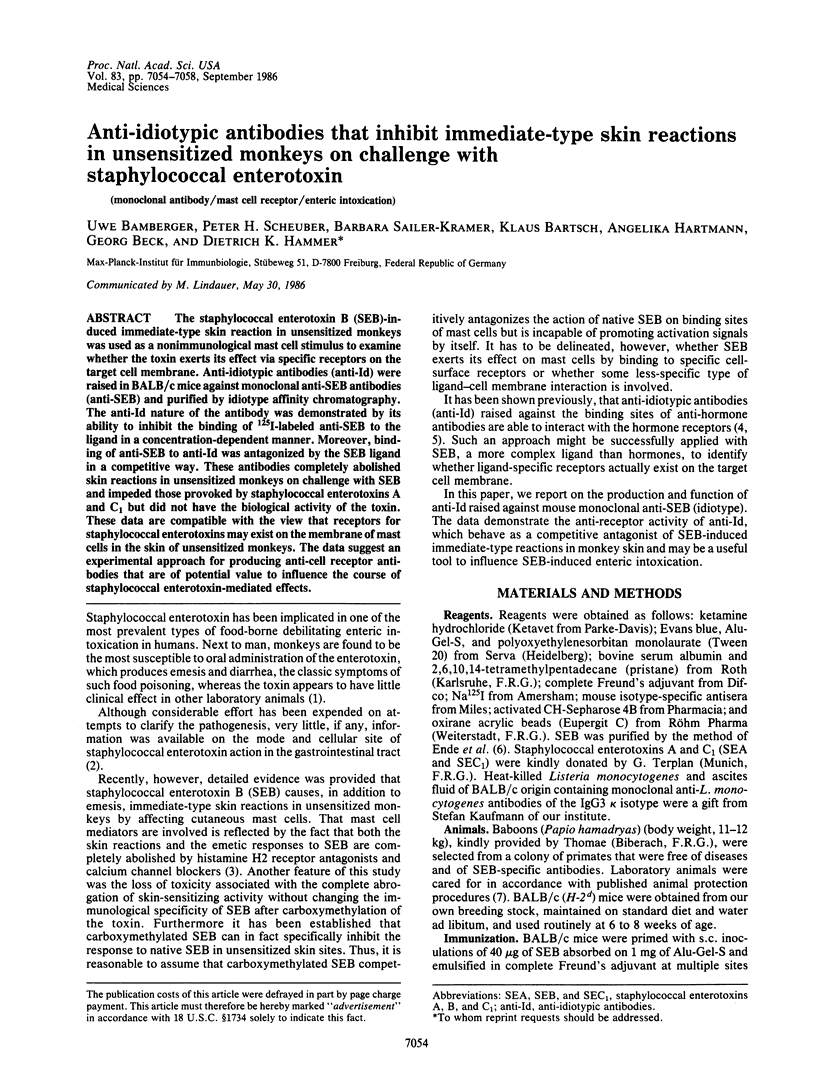
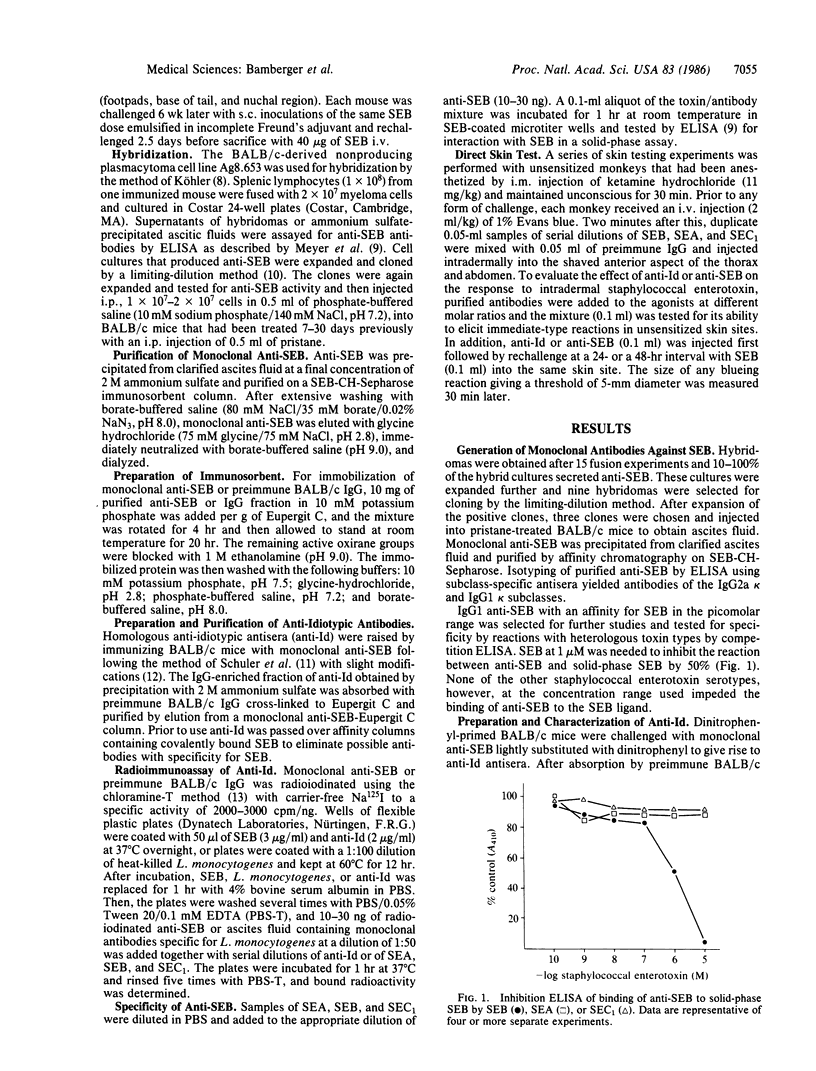
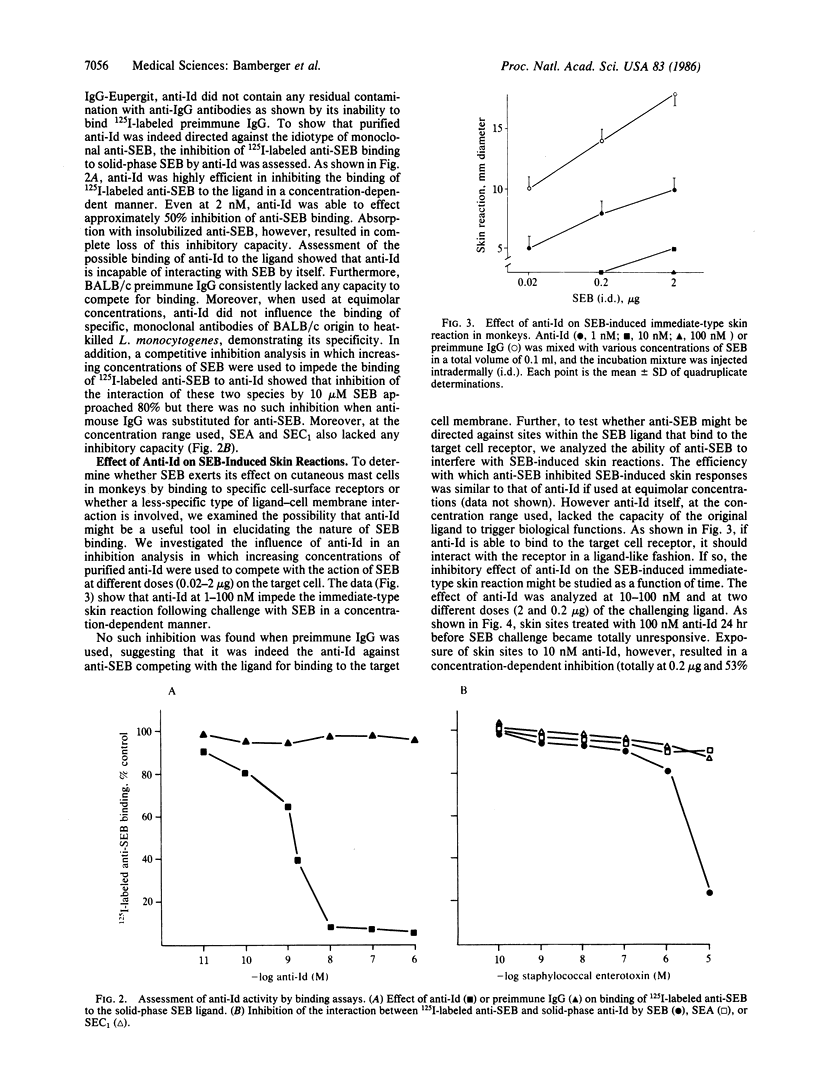
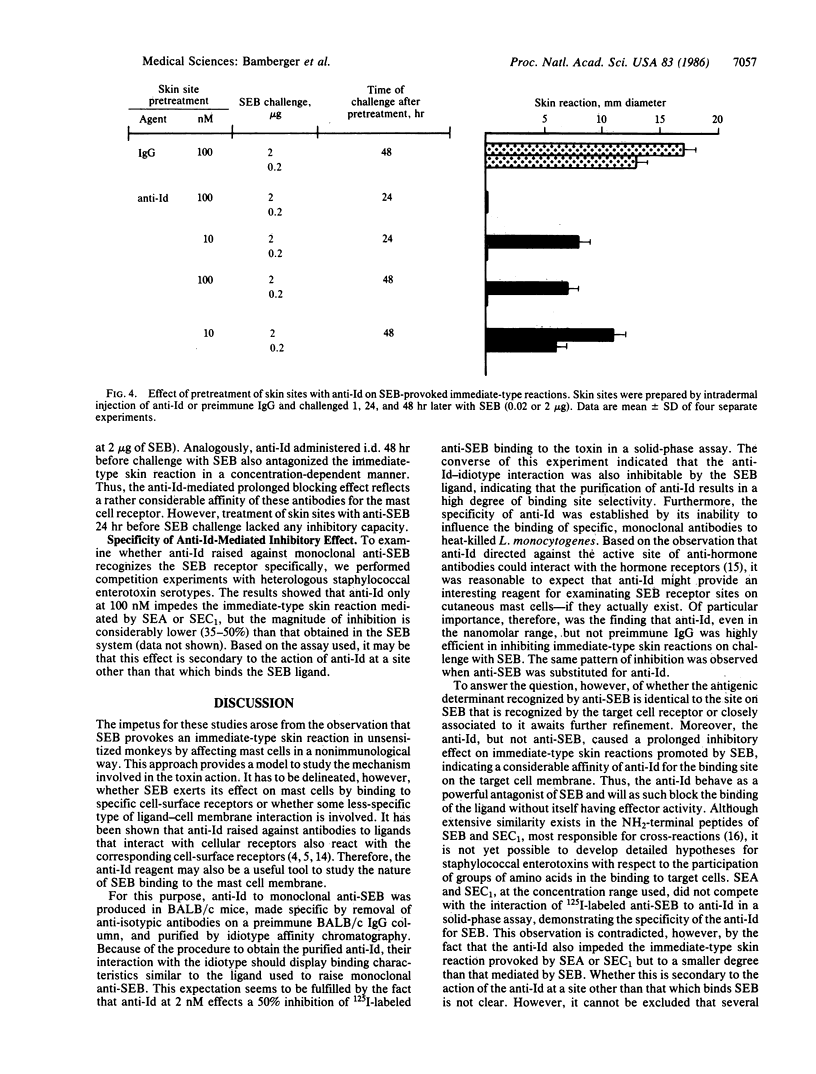
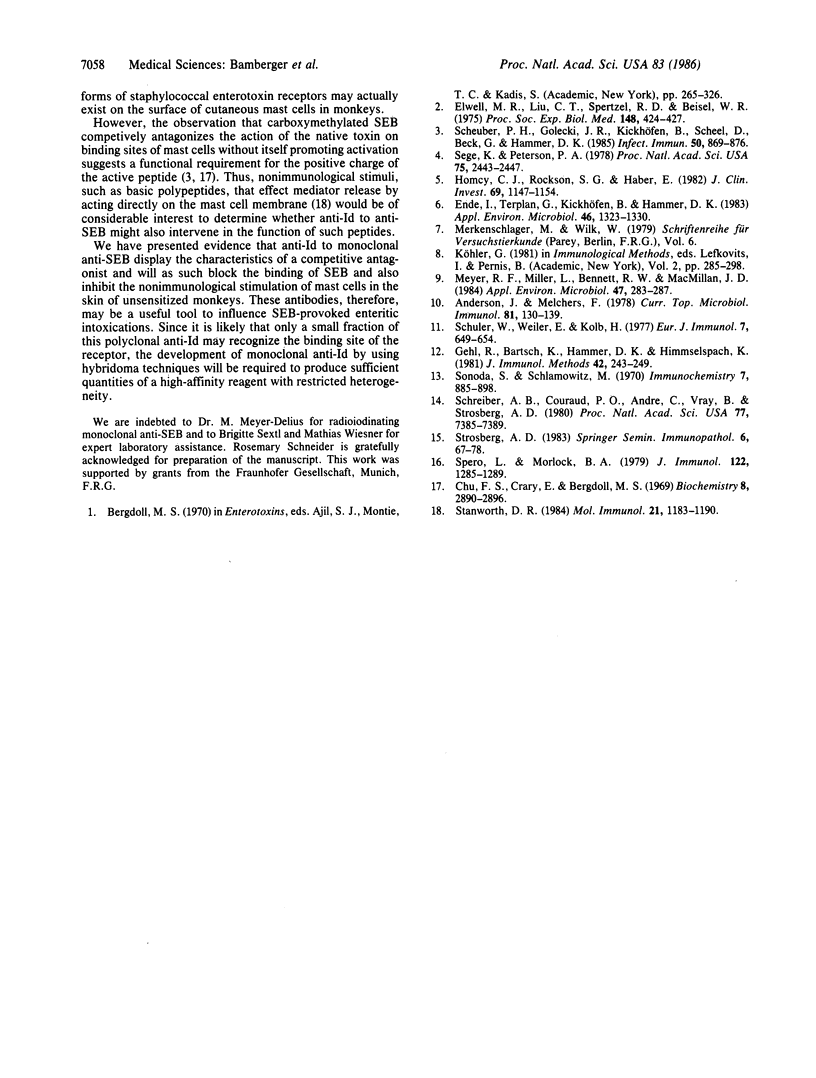
Selected References
These references are in PubMed. This may not be the complete list of references from this article.
- Andersson J., Melchers F. The antibody repertoire of hybrid cell lines obtained by fusion of X63-AG8 myeloma cells with mitogen-activated B-cell blasts. Curr Top Microbiol Immunol. 1978;81:130–139. doi: 10.1007/978-3-642-67448-8_19. [DOI] [PubMed] [Google Scholar]
- Chu F. S., Crary E., Bergdoll M. S. Chemical modification of amino groups in staphylococcal enterotoxin B. Biochemistry. 1969 Jul;8(7):2890–2896. doi: 10.1021/bi00835a030. [DOI] [PubMed] [Google Scholar]
- Elwell M. R., Liu C. T., Spertzel R. O., Beisel W. R. Mechanisms of oral staphylococcal enterotoxin B-induced emesis in the monkey (38553). Proc Soc Exp Biol Med. 1975 Feb;148(2):424–427. doi: 10.3181/00379727-148-38553. [DOI] [PubMed] [Google Scholar]
- Ende I. A., Terplan G., Kickhöfen B., Hammer D. K. Chromatofocusing: a new method for purification of staphylococcal enterotoxins B and C1. Appl Environ Microbiol. 1983 Dec;46(6):1323–1330. doi: 10.1128/aem.46.6.1323-1330.1983. [DOI] [PMC free article] [PubMed] [Google Scholar]
- Gehl R., Bartsch K., Hammer D., Himmelspach K. MOPC 104E IgM/anti-idiotype solid-phase inhibition assay as a model for screening myeloma proteins for ligand binding specificity. J Immunol Methods. 1981;42(2):243–249. doi: 10.1016/0022-1759(81)90154-x. [DOI] [PubMed] [Google Scholar]
- Homcy C. J., Rockson S. G., Haber E. An antiidiotypic antibody that recognizes the beta-adrenergic receptor. J Clin Invest. 1982 May;69(5):1147–1154. doi: 10.1172/JCI110550. [DOI] [PMC free article] [PubMed] [Google Scholar]
- Meyer R. F., Miller L., Bennett R. W., MacMillan J. D. Development of a monoclonal antibody capable of interacting with five serotypes of Staphylococcus aureus enterotoxin. Appl Environ Microbiol. 1984 Feb;47(2):283–287. doi: 10.1128/aem.47.2.283-287.1984. [DOI] [PMC free article] [PubMed] [Google Scholar]
- Scheuber P. H., Golecki J. R., Kickhöfen B., Scheel D., Beck G., Hammer D. K. Skin reactivity of unsensitized monkeys upon challenge with staphylococcal enterotoxin B: a new approach for investigating the site of toxin action. Infect Immun. 1985 Dec;50(3):869–876. doi: 10.1128/iai.50.3.869-876.1985. [DOI] [PMC free article] [PubMed] [Google Scholar]
- Schreiber A. B., Couraud P. O., Andre C., Vray B., Strosberg A. D. Anti-alprenolol anti-idiotypic antibodies bind to beta-adrenergic receptors and modulate catecholamine-sensitive adenylate cyclase. Proc Natl Acad Sci U S A. 1980 Dec;77(12):7385–7389. doi: 10.1073/pnas.77.12.7385. [DOI] [PMC free article] [PubMed] [Google Scholar]
- Schuler W., Weiler E., Kolb H. Characterization of syngeneic anti-idiotypic antibody against the idiotype fo BALB/c myeloma protein J558. Eur J Immunol. 1977 Sep;7(9):649–654. doi: 10.1002/eji.1830070914. [DOI] [PubMed] [Google Scholar]
- Sege K., Peterson P. A. Use of anti-idiotypic antibodies as cell-surface receptor probes. Proc Natl Acad Sci U S A. 1978 May;75(5):2443–2447. doi: 10.1073/pnas.75.5.2443. [DOI] [PMC free article] [PubMed] [Google Scholar]
- Sonoda S., Schlamowitz M. Studies of 125I trace labeling of immunoglobulin G by chloramine-T. Immunochemistry. 1970 Nov;7(11):885–898. doi: 10.1016/0019-2791(70)90051-0. [DOI] [PubMed] [Google Scholar]
- Spero L., Morlock B. A. Cross-reactions between tryptic polypeptides of staphylococcal enterotoxins B and C. J Immunol. 1979 Apr;122(4):1285–1289. [PubMed] [Google Scholar]
- Stanworth D. R. The role of non-antigen receptors in mast cell signalling processes. Mol Immunol. 1984 Dec;21(12):1183–1190. doi: 10.1016/0161-5890(84)90008-7. [DOI] [PubMed] [Google Scholar]
- Strosberg A. D. Anti-idiotype and anti-hormone receptor antibodies. Springer Semin Immunopathol. 1983;6(1):67–78. doi: 10.1007/BF01857367. [DOI] [PubMed] [Google Scholar]


